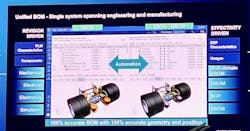As explained in the Automation World feature on the digital thread, though definitions of this technology concept may differ depending on the provider or manufacturing end user you’re speaking with, the core concept of the industrial digital thread is that it “builds on digital twin technology to connect granular, digital data about engineering and product design, plant floor equipment, manufacturing operations, supply chain processes and service histories. These data already exist in paper-based work instructions or tucked away in core enterprise systems like MES (manufacturing execution system), ERP (enterprise resources planning), and PLM (product lifecycle management). The goal of the digital thread is to provide the connective tissue and universal data access so that all workers—from plant floor operators to field support specialists—operate from the most current and relevant playbook.”
Siemens Digital Industries Software is following this line of thought with a focus on bills of materials (BOMs) data to connect every facet of a business’s operation in a digital thread from product design to production to the enterprise and supply chain.
Joe Bohman, executive vice president at Siemens Digital Industries Software, highlighted how, with the right software tool, users can “actually see how data is flowing—in this case, from the DBOM (design bill of material) to the EBOM (engineering) to the MBOM (manufacturing) to see each step of the production process.”
With these BOM data already in hand in various manufacturing systems, Bohman said the question becomes: “What are we doing with the data? How does the data work in these digital threads?”
In Siemens approach to the digital thread, Bohman explained “the way that the data works is through what we call our digital thread backbone. Ideation flows from systems engineering through design into the EBOM, MBOM and bill of process. And so, when you think about being able to connect an end-to-end process together, it's about being able to have the data flow—and this is how those data fit together. A lot of this is already in our Teamcenter backbone, which allows this data to snap together.”
According to Bohman, many Siemens’ customers report a 30% improvement in their velocity using this digital thread backbone.
3 strategy drivers
Rahul Garg, vice president of industrial machinery at Siemens Digital Industries Software at Siemens Industry Software, said one of the drivers behind Siemens focus on BOMs for its digital thread enablement came from the aerospace industry. As the company worked with customers in this industry, it realized that the concept would also work with other industries, especially regulated industries.
He pointed to three technology developments that have accelerated since we last met at IMTS in 2022 that are driving this BOM-centered digital thread approach.
First, a lot of design and build applications that were primarily installed, deployed and used on premises have moved to the cloud, which has made it very easy for a company of any size to get access to these applications in a subscription-based manner as opposed to paying a large amount of capex upfront and then having to manage them internally.
The second big change has been the emergence of generative AI into Siemens applications. With this, Garg said users now have an AI copilot helping them get their jobs done a lot more efficiently.
The third big development Garg pointed to is the industrial metaverse concept and the incorporation of photorealistic simulations inside the applications.
Garg said he thinks the biggest beneficiaries of these trends and associated technology capabilities are going to be the small and medium-sized companies “because they are the ones who will get the power of these applications at a much lower cost and can make it easily accessible for more people. As part of the whole ‘cloudification’ of our software, we are focused on user interactions, making it very easy to learn the applications and get up to speed quickly with built-in training and context-based help. So, when you're trying to do something and you're stuck, the system can prompt you with options. Having the ability to quickly analyze where you are at and prompting you to think about the next step based on what others have done successfully in similar circumstances changes the experience and will change the reality for smaller companies by giving them access to something that was only available to the large enterprise companies.”
This ease of access extends to reducing the complexity associated with design software. “In the past, users of NX, after installing it and getting it set up, could sometimes experience issues around how to best configure it, managing versions and track changes,” said Garg. “We have taken those experiences and developed best practices to show users how you should do it to get the most benefit. We have removed the setup complexity and show people how to get started. It gives users a good way to get a head start without having to debate and conceptualize it internally. We are now doing all that initial work for you.”
Workforce adoption
Of course, installing a new technology—no matter how easy it is to setup and manage—is only the first step. The biggest gap tends to be in user acceptance.
To address that, Garg said that, with NX X and some of the other SaaS products, Siemens provides ways to monitor usage. “This helps companies watch for patterns of usage to see where people might be getting stuck,” said Garg. “Typically, adoption stops when users get stuck and don't know how to move forward. With insights into adoption and usage patterns, we can see where users are experiencing issues so that training or some type of guided help can be delivered to address that.”



